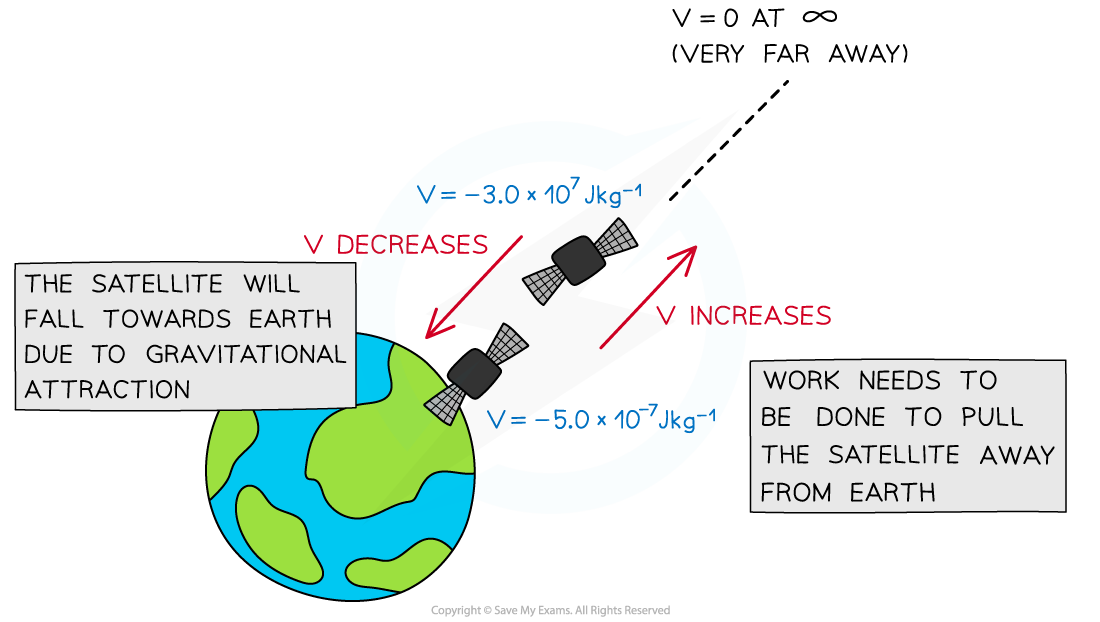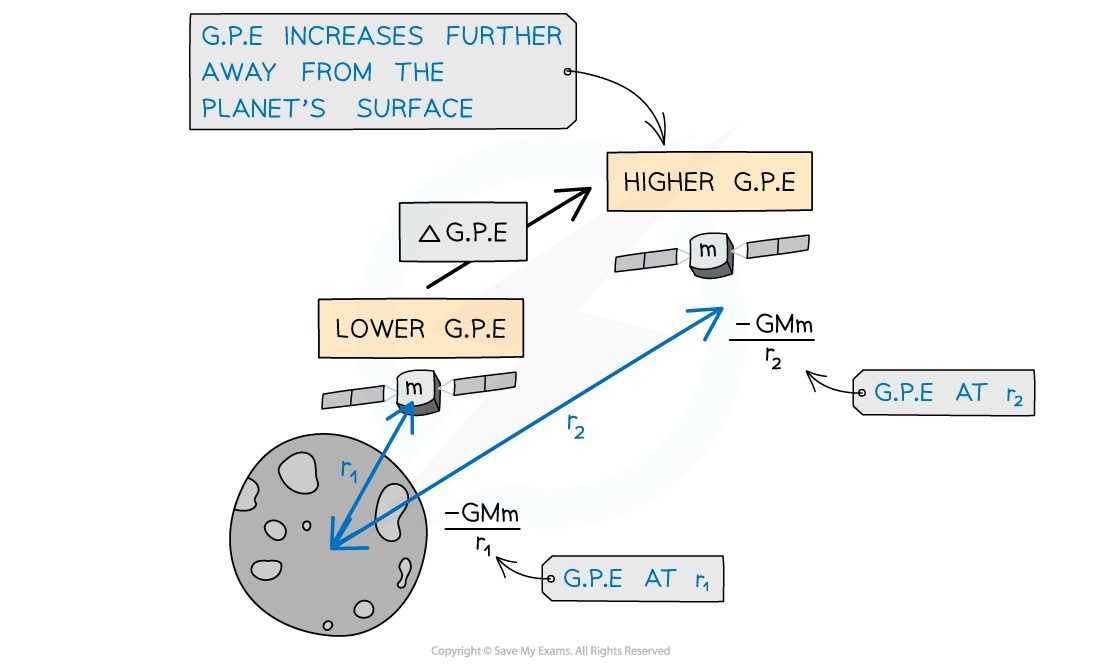Gravitational Potential (Cambridge (CIE) A Level Physics): Revision Note
Exam code: 9702
Gravitational potential
Gravitational potential, φ, at a point is defined as:
The work done per unit mass in bringing a small test mass from infinity to the point
Gravitational potential always has a negative value because:
It is defined as having a value of zero at infinity
Since the gravitational force is attractive, work must be done on a mass to reach infinity
On the surface of a mass (such as a planet), gravitational potential also has a negative value
The value becomes less negative, i.e. it increases, with distance from that mass
Work has to be done against the gravitational pull of the planet to take a unit mass away from the planet
The gravitational potential at a point depends on:
The mass of the object
The distance from the centre of mass of the object to the point
Changing gravitational potential

Gravitational potential decreases as the satellite moves closer to the Earth
Calculating gravitational potential
The gravitational potential
in a field due to a point mass, M is given by the equation:
Where:
= gravitational potential (J kg-1)
G = Newton’s gravitational constant
M = mass of the body producing the gravitational field (kg)
r = distance from the centre of the mass to the point mass (m)
Change in gravitational potential
Two points at different distances from a mass will have different gravitational potentials
This is because the gravitational potential increases with distance from a mass
Therefore, there will be a gravitational potential difference
between the two points
Where:
= initial gravitational potential (J kg–1)
= final gravitational potential (J kg–1)
The change in gravitational potential
is calculated using the equation:
Where:
r1 = initial distance from the centre of mass to the point mass (m)
r2 = final distance from the centre of mass to the point mass (m)
Worked Example
A planet has a diameter of 7600 km and a mass of 3.5 × 1023 kg. A rock of mass 528 kg accelerates towards the planet from infinity.
At a distance of 400 km above the planet’s surface, calculate the gravitational potential of the rock.
Answer:
Step 1: Write the gravitational potential equation
Step 2: Determine the value of r
r is the distance from the centre of the planet
Radius of the planet = planet diameter ÷ 2 = 7600 ÷ 2 = 3800 km
r = 3800 + 400 = 4200 km = 4.2 × 106 m
Step 3: Substitute in values
Examiner Tips and Tricks
Remember to keep the negative sign in your solution for gravitational potential. However, if you’re asked for the ‘change in’ gravitational potential, no negative sign should be included since you are finding a difference in values (between 0 at infinity and the gravitational potential from your calculation).
Gravitational potential energy between two point masses
Work done on a mass
When a small mass is moved away from a larger mass, work is done by the gravitational field
This is because the gravitational force is always attractive, so energy is needed to work against this attractive force
For example, an input of work is required to lift a satellite from the Earth’s surface into space
The work done in moving a mass
in a gravitational field is given by:
Where:
= work done (J)
= mass (kg)
= change in gravitational potential (J kg−1)
Gravitational potential energy
In a Radial field, gravitational potential energy (GPE) describes the energy an object possesses due to its position in a gravitational field
The gravitational potential energy of a system is defined as:
The work done to assemble the system from infinite separation of the components of the system
The equation for GPE between two point masses m1 and m2 at a distance r is:
Where:
G = universal gravitational constant (N m2 kg–2)
m1 = larger mass producing the field (kg)
m2 = mass moving within the field of m1 (kg)
r = distance between the centre of m1 and m2 (m)
Gravitational potential energy vs distance

Gravitational potential energy increases as a satellite leaves the surface of the Moon (of mass M)
Change in gravitational potential energy
Two points at different distances from a mass will have different gravitational potentials
This is because the gravitational potential increases with distance from a mass
Therefore, there will be a gravitational potential difference
between the two points
Where:
= initial gravitational potential (J kg–1)
= final gravitational potential (J kg–1)
The work done against a gravitational field is equal to the change in gravitational potential energy
The change in GPE when a small mass m2 moves towards, or away from, another larger mass m1 is given by:
Where:
m1 = mass that is producing the gravitational field (e.g. a planet) (kg)
m2 = mass that is moving in the gravitational field (e.g. a satellite) (kg)
r1 = first distance of m2 from the centre of m1 (m)
r2 = second distance of m2 from the centre of m1 (m)
Examiner Tips and Tricks
Make sure to not confuse the ΔG.P.E equation with
ΔG.P.E = mgΔh
The above equation is only relevant for an object lifted in a uniform gravitational field (close to the Earth’s surface). The new equation for G.P.E will not include g, because this varies for different planets and is no longer a constant (decreases by 1/r2) outside the surface of a planet.
Remember, multiplying two negative numbers equals a positive number, for example:

Unlock more, it's free!
Did this page help you?